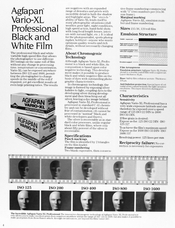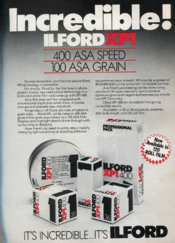I finally finished my 100ft roll of XP2+ Super. And I will never be using it again. Before I list my reasons for disliking the film, I will make the mandatory acknowledgement of user skill/error and other YMMV bits. And now here are my reasons to stay away from it:
If you expose and develop it the same way as any other color negative ISO 400 film, you will end up with rough shadow grain and high contrast in all but the flattest lighting conditions. While the highlights will be remarkably smooth, the shadows look really nasty. The base+fog density is quite high and perhaps its a contributing factor. On the recent vacation I exposed the last 6 rolls of it, often side-by-side with Delta 100 and Portra 160. The results were not pretty: zones 2-4 look rough, then you have a compressed mid-range, and the highlight density shoots up quickly but never really 100% blocks. It works better on scenes that are brightly lit with minimum shadows. If you take advantage of its highlights-compressing ability the result can look really neat, but you get the same look if you just over-expose a regular CN film and properly convert to B&W. You will get more tonal range and less grain for the same price.
In most situations you'll need +2EV exposure compensation to minimize that harsh look. Essentially this is an ISO 100 film which competes with Delta 100 or TMX. But Delta 100 is far sharper and finer grained. And you get to deploy the usual B&W development tricks to expand/compress the range.
I also suspect that one can get better results from XP2+ by exposing it as ISO 100 film and also pulling or developing at a lower temperature. But this would require developing it separately from all other chromogenic films which is too much pain for me. And finally, I am noticing that the emulsion itself is more fragile and prone to scratching. In that sense it's similar to Fomapan films.
TLDR:
- Not really compatible with C-41. I think it requires pulling to tame high contrast and expand the range.
- You must pick: rough ISO 400 grain or ISO 100 speed
- Low acutance when over-exposed
- High price
Basically I see no point in using XP2+. When you do need true ISO 400 speed something like Delta 400 or TMY will work better. If you need chromogenic latitude, shoot Portra and convert to B&W. And if you need super fine grain, shoot ISO 100 T-grain B&W films. I think whoever said that the only point of it is to allow consumers to get B&W photos from 1-hr minilabs is true. That is not my use case.
[EDIT] Regarding the price: it used to be more expensive than Delta 100 but not anymore. So perhaps that point is no longer valid or geo-dependant.
Below is the typical example. +1EV compensation, center-weighted metering. The highlights are on the verge of being completely blown out, while the shadows are still crushed. Giving it more light would not have helped. Meanwhile the light is fairly soft, the sun is behind a cloud. From the lighting perspective this scene is quite manageable and it would have looked much better on Delta 400. This is also quite noticeable when you look at a linear histogram while scanning. This film just doesn't hold much range!
View attachment 350344










